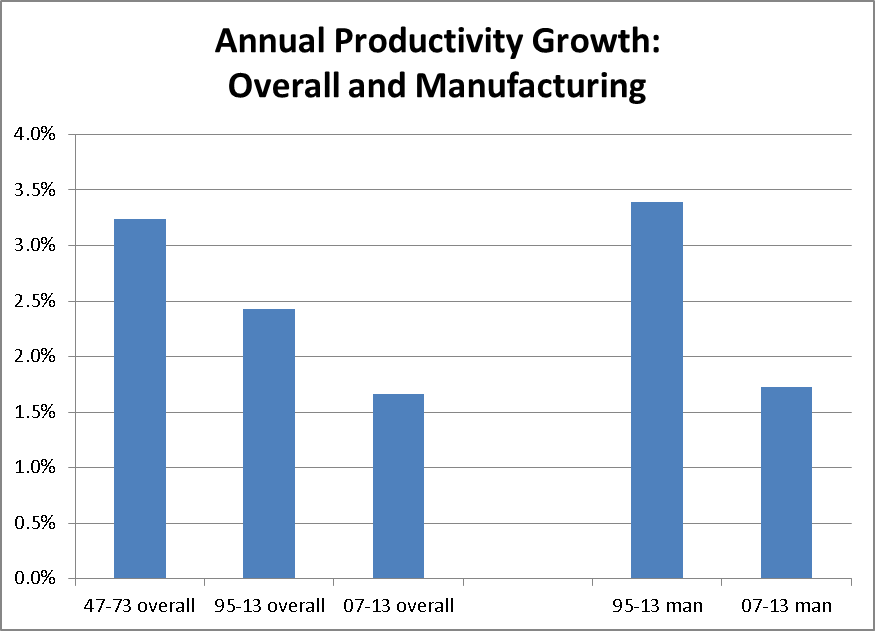March 27, 2014
There is a growing industry in the United States of people promoting stories about how robots and other technological innovations are going to make us all unemployed. Unfortunately Harold Meyerson seems to have taken these people seriously.
Meyerson cites a study showing that technology is likely to slash employment in large sectors of the economy and then tells readers:
“Eventually, however, as computers pick up more and more skills, we will have to embrace the necessity of redistributing wealth and income from the shrinking number of Americans who have sizable incomes from their investments or their work to the growing number of Americans who want work but can’t find it. That may or may not be socialism; certainly, it’s survival.”
The problem with this story is that it is 180 degrees at odds with the data. Robots and computers seem to fascinate people as something new and different, but actually they are just forms of productivity growth. The issue is simply one of how fast we might expect these new technologies to increase productivity and displace workers. The answer we have been getting to date from the Bureau of Labor Statistics (BLS) is not very fast.
Here’s what the picture looks like from the latest data.

Source: Bureau of Labor Statistics.
As can be seen, the overall rate of productivity growth in the years since the speedup began in 1995 has been less than 2.4 percent annually. This compares to a rate of 3.2 percent in the years 1947-73, when unemployment was low and wage growth was strong. (Due to measurement issues such as the difference between gross and net output and differences in price indices, “usable” annual productivity growth was about 0.3 percentage points higher in the years 1947-73 relative to the official numbers.) In the more recent years since the downturn, productivity growth has fallen off to less than 1.7 percent annually.
If we look to manufacturing alone, there is a bit more of a story, but still not much. Productivity growth in the years since 1995 has averaged 3.4 percent, this is slightly higher than 3.2 percent overall rate of productivity growth in the 1947-1973. That can’t be enough to tell a qualitatively different story, especially since manufacturing now accounts for less than 10 percent of total employment. Furthermore manufacturing productivity growth was almost certainly stronger than overall productivity growth in the years 1947-73 golden age also (BLS does not give that series), so that would likely mean that it was faster than the rate we have seen in manufacturing since 1995. As with overall productivity, manufacturing productivity growth has also slowed sharply since 2007.
So why should we think that productivity growth will lead to a problem of too few jobs, as opposed to providing a basis for rising wages and living standards? if there is some huge productivity boom facing us in the near future, it is hiding pretty well from the folks gathering the data at BLS.
This is an important point because socialism or large-scale redistribution are big deals. We don’t expect that our politicians in Washington will be likely to embrace either concept any time soon. But much smaller and simpler policies can ensure that workers have jobs and share in the gains of economic growth. If we get the value of the dollar down against other currencies, we will reduce the trade deficit and create millions of jobs. President Obama could negotiate a decline in the value of the dollar against the currencies of our major trading partners as President Reagan did in the mid-1980s. We could also boost demand with increased stimulus and we could give more workers jobs through work sharing policies. (Read the book, it’s free.)
Anyhow, the point is that we are not in a brave new world where the basics of economics and technology are destined to screw the vast majority of workers absent major changes in public policy. We are in the vicious old world where the bad guys are actively manipulating public policy in ways that are screwing workers now. If we are going to make any headway in reversing this process we have to keep our eye on the ball.







Comments